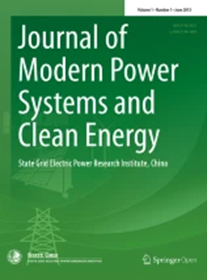基于轨迹规划和滑模控制的固体氧化物燃料电池系统功率切换
IF 6.1
1区 工程技术
Q1 ENGINEERING, ELECTRICAL & ELECTRONIC
Journal of Modern Power Systems and Clean Energy
Pub Date : 2024-11-07
DOI:10.35833/MPCE.2024.000284
引用次数: 0
摘要
为了提高固体氧化物燃料电池(SOFC)系统的安全性,避免功率切换时产生大量污染物,本文设计了一种基于轨迹规划和滑模控制(TP-SMC)的功率切换策略。首先通过仿真分析提出了功率切换策略的设计要素。然后,根据测试得到的气体传输延迟时间和气体流量变化,实现了轨迹规划(TP)。实践证明,与其他功率切换策略相比,基于 TP 的功率切换策略具有明显更好的控制性能。此外,考虑到 TP 在实际应用中的缺点和问题,本文在 TP 的基础上引入了滑模控制(SMC),以改进功率切换策略。最终的仿真结果也证明,TP-SMC 能有效抑制气体流量和输气延迟时间不确定性的影响。与 TP 相比,TP-SMC 可确保在不确定条件下,SOFC 系统在功率切换过程中不会出现燃料过剩和温度超限现象。同时,氮氧化物的排放也在正常和可接受的范围内。本文可以指导实际 SOFC 系统的功率切换过程,避免安全问题和氮氧化物的过量产生,这对提高 SOFC 系统的性能和使用寿命非常有帮助。本文章由计算机程序翻译,如有差异,请以英文原文为准。
Power Switching Based on Trajectory Planning and Sliding Mode Control for Solid Oxide Fuel Cell Systems
To improve the safety of the solid oxide fuel cell (SOFC) systems and avoid the generation of large amounts of pollutants during power switching, this paper designs a power switching strategy based on trajectory planning and sliding mode control (TP-SMC). The design elements of the power switching strategy are proposed through simulation analysis at first. Then, based on the gas transmission delay time and the change of gas flow obtained from testing, trajectory planning (TP) is implemented. Compared with other power switching strategies, it has been proven that the power switching strategy based on TP has significantly better control performance. Furthermore, considering the shortcomings and problems of TP in practical application, this paper introduces sliding mode control (SMC) on the basis of TP to improve the power switching strategy. The final simulation results also prove that the TP-SMC can effectively suppress the impact of uncertainty in gas flow and gas transmission delay time. Compared with TP, TP-SMC can ensure that under uncertain conditions, the SOFC system does not experience fuel starvation and temperature exceeding limit during power switching. Meanwhile, the NOx emissions are also within the normal and acceptable range. This paper can guide the power switching process of the actual SOFC systems to avoid safety issues and excessive generation of NOx, which is very helpful for improving the performance and service life of the SOFC systems.
求助全文
通过发布文献求助,成功后即可免费获取论文全文。
去求助
来源期刊

Journal of Modern Power Systems and Clean Energy
ENGINEERING, ELECTRICAL & ELECTRONIC-
CiteScore
12.30
自引率
14.30%
发文量
97
审稿时长
13 weeks
期刊介绍:
Journal of Modern Power Systems and Clean Energy (MPCE), commencing from June, 2013, is a newly established, peer-reviewed and quarterly published journal in English. It is the first international power engineering journal originated in mainland China. MPCE publishes original papers, short letters and review articles in the field of modern power systems with focus on smart grid technology and renewable energy integration, etc.
 求助内容:
求助内容: 应助结果提醒方式:
应助结果提醒方式:


